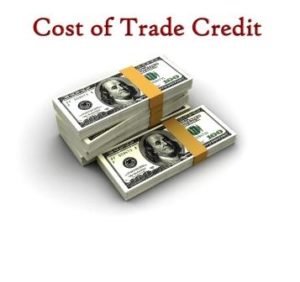Does Trade Credit also Cost?
The statement “trade-credit has no explicit cost” is a misleading statement. It is only partially correct. The trade credit is free only till the discount period. Not only free, but it also has an additional advantage of the discount. After the discount period till the net period, not taking benefit of the discount allowed by the supplier is clearly an opportunity cost of trade credit. Other costs, under certain situations, include loss of goodwill, the cost of administration and accounting, loss of suppliers, etc.
Let’s take the example of ‘2/10 net 30’ as the payment terms.
The cost of Trade Credit till the Discount Period
If the payment is made on or before the last day of the discount period, the buyer will benefit from the discount received, i.e., 2% of the bill amount. Therefore, there is no cost, but there is an additional benefit of 2%.
Approximate Annual Cost of Trade Credit after the Discount Period

If the payment is made after the discount period till the net period, the benefit of the discount will not be gained. That loss of gain is the cost of trade credit for this period. In other words, we are forgoing the discount of 2% for enjoying the credit of, say, 20 days. The annualized cost of such credit is 37.2% which will be less than the bank borrowings.
How to Calculate the Cost of Trade Credit is explained with the help of the following formula
Cost of Trade Credit (after Discount Period)=(% of Discount)/(100-% of Discount)×365/(Payment Date-Discount Period)
The following table has been prepared using the above formula and our current example of ‘2/10 net 30’.
| Payment Date* | Cost of Table | Credit Terms |
| 1 to 10 | Explicitly Free andAdditional Benefit of Discount | ‘2/10 net 30’ |
| 11 | 744.9% (losing 2% for 1 Day) | ‘2/10 net 30’ |
| 20 | 74.5 | ‘2/10 net 30’ |
| 30 | 37.2 | ‘2/10 net 30’ |
| 60 | 14.9 | ‘2/10 net 60’ |
| 90 | 9.3 | ‘2/10 net 90’ |
The decision regarding whether to utilize the trade credit is an important task of the finance manager. With the above calculations, it is easily possible. The manager knows the bank’s cost of other short-term borrowings, says 12%. We can notice from the table that if the payment is made on the 11th day, the cost is highest.
Also Read: Trade Credit
The cost of trade credit reduces with an increase in the time of payment, and it is the lowest on the last day of the net period. Under such a situation, the manager’s priority of actions would be as follows:
- Pay at the end of the discount period (On the 10th Day) and enjoy the free credit of 10 days and a discount of 2%.
- Pay at the end of the net period (On the 30th Day). By that time, we had foregone the discount and already incurred a cost of 2%. It is better to utilize the whole period until the dues are going to be the same. But, keep in mind that it should be a last resort because compared to the company’s cost of funds, i.e., 12%, it is much costlier (37.2%). Therefore, it is not advisable to use the trade credit till the net period. Option 1 is the best.
What are the Situations when using Trade Credit can be Advantageous?
We have taken more liberalized credit terms as an example in the table. We see that if the terms are ‘2/10 net 60’, where the net period is increased by 30 days, it is still not beneficial compared with 12% to 14.9%. If the credit terms are ‘2/10 net 90’, where net days are extended by 60 days, it is beneficial to use the trade credit (9.3% is less than 12%).
Qualitative Costs of Trade Credit
Following are the Qualitative Costs or Disadvantages of Trade Credit which are difficult to quantify but not advisable to be ignored.
Supplier’s Costs
For allowing trade credit, a supplier incurs various expenses such as follows:
- The cost of funds he invests in the book debts.
- Cost of cash discount
- Probable risk of bad debts/ provisions of bad debts
- Expenses for running special departments to manage trade credit, sales, collection, legal, etc.
Under normal circumstances, it is evident that those expenses will be recovered from the buyer only. Therefore, all the above expenses are part of the selling price paid by the buyer.
Goodwill at Stake
Stretching the accounts payable beyond the credit limit and enjoying unreasonable credit impacts the goodwill of a firm. Suppliers in the market would avoid such buyers, stop supplies without payment, etc.
The cost of Administration and Accounting
There are costs of managing the trade credit/ accounts payable in terms of administration, monitoring, and accounting.
Supplier’s Relations at Stake
Some suppliers may take a bold step and may end the relations with the buyer due to non-conformance of credit terms by the buyer.


your solution is good…but how can I calculate this, 2/10, net 11
Just the way, we have calculated 2/10 net 30 in the example above.
2/10, net 11 means ‘Payment for up to 10 days, you will get 2% discount on the bill. On 11th days onwards, you will have to pay the net invoice amount’